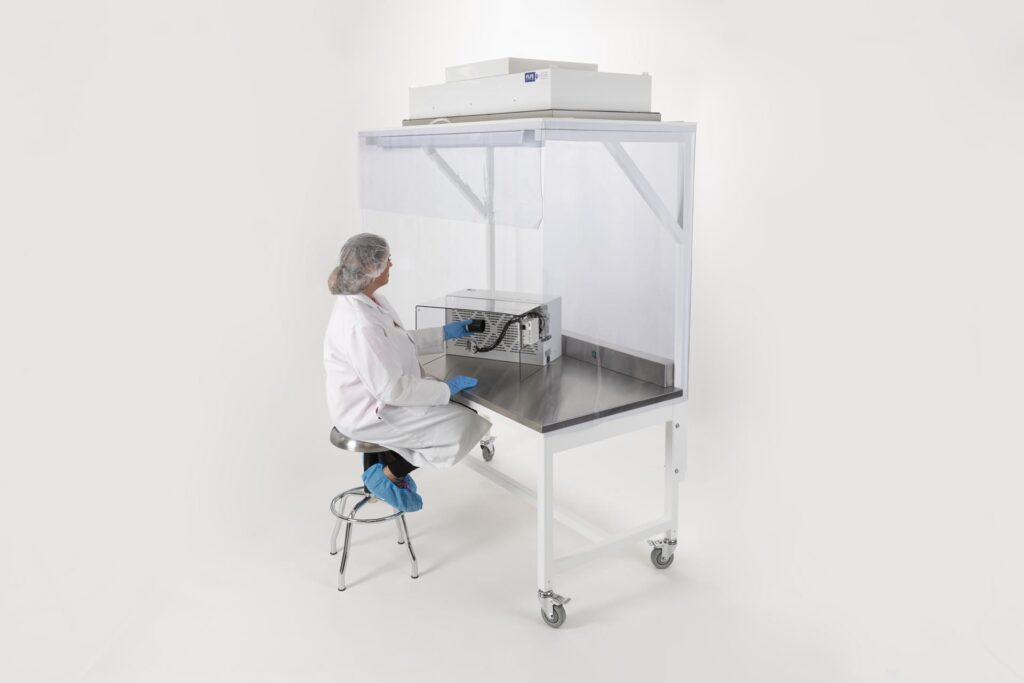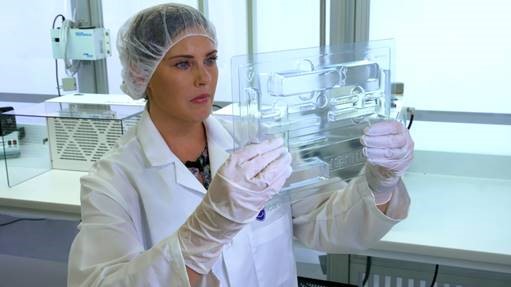Making cleanrooms cleaner
The Problem
Cleanrooms are a vital part of many manufacturing processes. Expect to find meticulously controlled cleanrooms in the pharmaceutical, medical device and electronic sectors where contamination control is paramount.

Not all cleanrooms are created equal, however, they are categorised according to ISO 14644 which has a scale of 9 – 1, 1 being the cleanest. This standard is based on the number and size of particles per volume of air. Many processes do not require the highest levels.
Despite the PPE worn, the absence of windows, and the sealed entrances, there remains an invisible challenge in cleanrooms. John Bagby, Director of Innovation and Engineering at Fraser Anti-Static Techniques, explains:
So, ironically, the very process that is delivering clean air into the cleanroom is causing any particulate matter that is present to make its way to the very place that needs to be kept clean. Combine this with other static-generating processes such as contact and separation or friction events, and a very significant static problem emerges.”
If cleanroom processes fail, products are rejected or need to be reworked, costs are increased and revenues fall.
That’s where static neutralisation comes in.
The Solution
Fraser’s product experts design solutions for cleanroom customers. The process involves understanding the specific manufacturing process, the static problems themselves and the construction and layout of the cleanroom, as well as its required ISO standard.
Typically, the solution will be introducing Fraser’s Ionstorm system, usually in the airflow, below the HEPA filtration system. This neutralises the air and carries ionisation down to the work area.
Effective neutralisation isn’t quite that simple, however. Fraser’s technical team will work to understand the static charges and residual balance targets.
John explains;
“In many cases, particularly where the customer is working with electronics, they may set targets for the residual balance to protect sensitive components which can be damaged by very low-levels of charge. Where electronics are not involved, there will still be a desire to keep the final charge down to a low level. Visible dust attraction starts at 1kV so a target of 500V might be required. The Ionstorm system has controls both for adjusting the power and the balance of positive and negative ionisation, and for adjusting the frequency of the output it gives. Frequency is analogous to distance control; a low frequency bar switches between positive and negative ionisation more slowly giving long pulses of ionisation creating a longer range. A high frequency bar rapidly fires out lots of positive and negative ions in quick succession, which is powerful at short range only. The Ionstorm solution is flexible and can be adjusted to achieve the optimum distance and balance. We’d typically site Ionstorm within two metres of the work area to achieve the best result.”
After installation, a charge plate monitor (CPM) allows the engineer or customer to test the rate of neutralisation and the balance of negative and positive ions at the target distance. The bar settings can then be adjusted to get best results. Periodic checks with CPMs ensure the best ongoing performance.
In Practice
Customer Example: Pharmaceutical manufacturing
Unsurprisingly and reassuringly, pharmaceuticals are produced in tightly controlled environments. Both medical device and pharmaceutical medications require cleanroom technology at multiple stages, and often throughout the production process.
Fraser is working with a cleanroom Original Equipment Manufacturer OEM for the pharmaceutical industry to design a powerful and cost-effective anti-static solution for its cleanrooms. The cleanroom customer manufactures large plastic liners which are supplied to the pharmaceutical industry for medicine production. These single-use liners are employed to save time and avoid cross-contamination.
The company has strict quality controls in place meaning that the cleanliness levels of the products leaving the facility are meticulously checked. Any product that is contaminated with particulate such as dust, hair or similar, is rejected. This results in increased costs and reduced revenue. Introducing a static control solution throughout the facility reduces the attraction of contamination and, in turn, the number of products rejected, ultimately improving profit margins.
As well as static charge created by the necessary HEPA air filtration systems in the cleanrooms, even greater levels of static are generated during the production process itself. As well as component handling, there is contact separation with rolls of plastic film, creating large static charges, as well further multiple static-generative processes such as cutting and sealing. The anti-static challenge is therefore significant and requires a specifically designed solution, tailored to each stage of the process.
Fraser has designed a solution using its Ionstorm bars. The bars are placed on the ceiling throughout the cleanroom. One typical cleanroom in this facility will have 15 x 8.5 metre bars to handle the static charges being generated.
Fraser’s International Technical Manager, Jason Morgan, explains:
“The combination of the baseline cleanroom static challenges that exist in nearly all cleanrooms, with a continual stream of static-generative processes throughout production, required us to design a powerful and robust solution.
“Our design floods the cleanrooms with ionisation to neutralise charge and reduce contamination on individual components. Introducing static management at each stage of the production process, ensures components are kept as clean as possible before they get picked and taken to the next stage of the process. This results in minimal contamination of the end product, and ultimately delivers a reduced rejection rate.”
In addition to the Ionstorm bars, the Fraser design introduced ionising guns that are used in a negative pressure isolator box with a separate filtered extraction system. The ionised air gun uses compressed air to neutralise and clean any particulates off the surface of the parts as they are picked for each job. These clean parts are then batched and placed into sealed containers before being delivered to the next stage of the manufacturing process.
Customer Example: Automotive electronics
Fraser has recently delivered an anti-static solution for a semiconductor plant of a leading automotive manufacturer which is delivering significant results in quality control and improvement.
The plant is manufacturing integrated circuit (IC) chips with lithography, etching, and deposition processes. The cleanroom environments during the process are subject to the electrostatic discharge issues typical of cleanrooms, caused by both the air filtration system and the manufacturing processes themselves. Product contamination results in increased costs and, in turn, reduced revenue.
Fraser has designed the Ionstorm solution which, in this in this example, enabled the customer to achieve specific performance criteria. Typical in an electronics environment, a residual balance of under +/- 150V and a static neutralisation performance of 1000V to 100V within 60 seconds at a working distance of 2m below the installed bars.
Opportunities
There are thousands of cleanroom facilities and many cleanroom manufacturers worldwide. A significant proportion of them will require static control. If you can identify opportunities within your territory, then your Fraser Account Manager will be able to support you in a competitive sale. These opportunities can be very valuable. A proven approach is through cleanroom providers/manufacturers who will themselves have many customers.
Last Updated: 22 May, 2024
